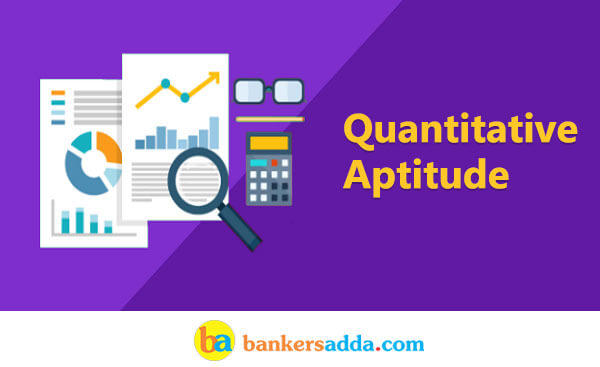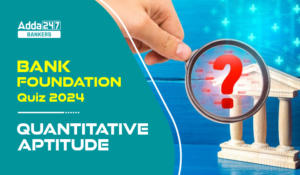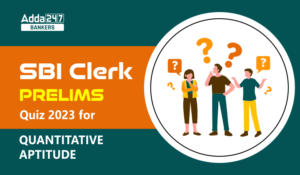Dear Students,
Quantitative Aptitude Questions for IDBI Executive Exam
Quantitative Aptitude Section has given heebie-jeebies to the aspirants when they appear for a banking examination. As the level of every other section is only getting complex and convoluted, there is no doubt that this section, too, makes your blood run cold. The questions asked in this section are calculative and very time-consuming. But once dealt with proper strategy, speed and accuracy, this section can get you the maximum marks in the examination. Following is the quiz on Quantitative Aptitude to help you practice with the best of latest pattern questions.
Q1. The ratio of the radius of two right circular cylinders (A and B) is 2 : 5. The ratio of the heights of cylinders A to B is 3 : 1. What is the ratio of the volumes of cylinders A to B?
(a) 12 : 25
(b) 9 : 25
(c) 9 : 20
(d) 3 : 5
(e) 12 : 35
Q2. Manoj takes twice as much time as Ajay and thrice as much time as Vijay to finish a piece of work. They together finish the work in 1 day. What is the time take by Manoj to finish the work?
(a) 5 days
(b) 6 days
(c) 7 days
(d) 8 days
(e) 4 days
Q3. The distance between two places A and B is 320 km. A car departs from place A for place B at a speed of 55 kmph at 7 am. Another car departs from place B for place A at a speed of 45 kmph at 11 am. At what time will both the cars meet each other?
(a) 11 am
(b) 12 noon
(c) 1 pm
(d) 12: 30 pm
(e) 1: 30 pm
Q4. The number of employees working in a company is increased by 35% and the wages per head are decreased by 35%. What is the percentage decrease in the total wages?
Q5. Suraj loses 13% of his money and after spending 65% of the remaining he is left with Rs 1522.5. How much money did he have in the beginning?
(a) Rs 6000
(b) Rs 6525
(c) Rs 7500
(d) Rs 5225
(e) Rs 5000
Q6. A bag contains 4 Redmi mobiles, 3 Nokia mobiles and 6 Samsung mobiles. 8 mobiles are drawn at random. What is the probability that the drawn mobiles has no Redmi mobile?
(a) 1/3
(b) 2/5
(c) 142/143
(d) 9/1426
(e) 1/143
Q7. In three numbers, the first is twice the second and thrice the third. If the average of three numbers is 99, then the first number is
(a) 165
(b) 162
(c) 164
(d) 169
(e) 168
Q8. Swati can copy 50 pages in 10 hours; she and Upendra together can copy 300 pages in 50 hours. In what time can Upendra copy 40 pages?
(a) 30 hours
(b) 35 hours
(c) 40 hours
(d) 50 hours
(e) 45 hours
Q9. The simple interest accrued on an amount of Rs 18500 at the end of three years is Rs 6105. What would be the compound interest accrued on the same amount at the same rate of interest for the same period?
(a) Rs 6801.17
(b) Rs 6900
(c) Rs 7000
(d) Rs 7801.23
(e) Rs. 6701.17
Q10. A man rows to a place 210 km away and comes back to the starting point. If the speed of the stream is 3 kmph and the speed of the boat in still water is 18 kmph, then what is the total time taken by him?
(a) 24 hours
(b) 25 hours
(c) 26 hours
(d) 22 hours
(e) 28 hours
Q11. 4 men can complete a piece of work in 7 days. 7 children can complete the work in 16 days. In how many days can 3 men and 2 children together complete the work?
(a) 7 days
(b) 16 days
(c) 12days
(d) 8 days
(e) 9 days
Q12. Mohan Lal purchased 8 dozen pencils at Rs 60 per dozen and sold 5 dozen at 20% profit and the remaining at 10% profit. What is his percentage profit in this transaction?
(a) 15%
(b) 16.25%
(c) 18%
(d) 20%
(e) 17.25%
Q13. In how many different ways can the letters of the word CRIME be arranged?
(a) 120
(b) 300
(c) 72
(d) 44
(e) 160
Q14. A wire is moulded into a circle of radius 14 m. Then the wire is bent and shaped into a rectangle of length 24 m. Find the area of the rectangle thus formed.
(a) 188m²
(b) 180m²
(c) 360m²
(d) 480m²
(e) 380m²
Q15. A person travelled a distance of 30 km in 8 hours. He travelled partly on foot at the rate of 3 kmph and partly on bicycle at the rate of 5 kmph. The distance travelled on foot is?
(a) 14 km
(b) 15 km
(c) 16 km
(d) 17 km
(e) 20 km
You may also like to Read:



 Quantitative Aptitude Quiz For Bank Foun...
Quantitative Aptitude Quiz For Bank Foun...
 Quantitative Aptitude Quiz For SBI Clerk...
Quantitative Aptitude Quiz For SBI Clerk...



